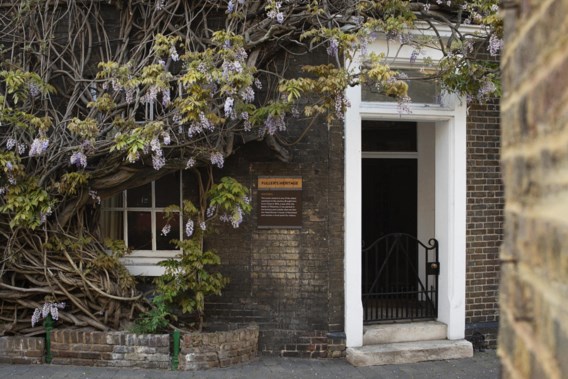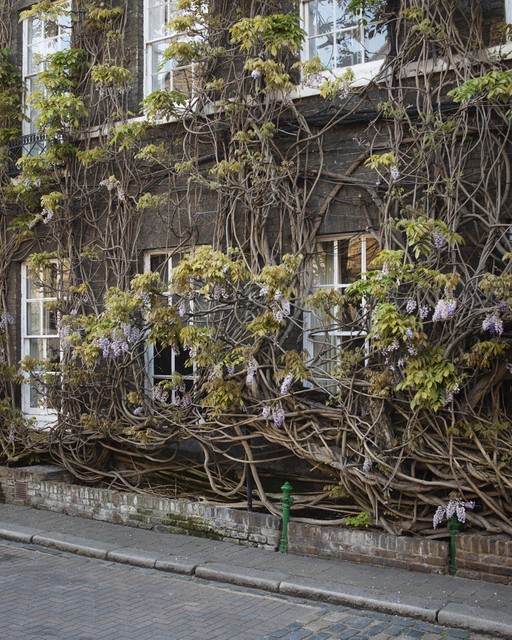It has to be the biggest story in west London’s Chiswick district: the old Fuller’s Griffin brewery may have the oldest wisteria in the country. And that the young plant placed there in 1816 may well be one of the first two European specimens. Wisteria sinensis, Chinese wisteria, the species most often found in gardens here. Another plant would have been taken to the famous Kew Botanic Gardens, about two miles away, but would not have survived.
It is an evergreen in London travel guides and on tours organized by the brewery. Sometimes the “maybe” even disappears entirely, as in a thought-provoking video that popular British botanist James Wong posted on Instagram this week to his 527,000 followers: “This is the oldest wisteria in Europe,” says Wong, posing in Fuller. “Almost every wisteria grows from this one plant Today In Europe, cloned.”
Mozart among plants
“That’s not entirely true,” Wisteria expert Marc Libert says cautiously. He is a collection holder at the Ghent University Botanical Garden and has been an avid wisteria collector for 30 years. “Mozart among plants,” he calls wisteria. “Everyone knows wisteria, and it is unique in its color, fragrance and flowering. The number of flowers is phenomenal, sometimes almost too much.
It is true that wisterias can get very old: “There is one in Japan Wisteria floribunda which is said to be 600 years old.” And it is also true that wisteria can be cloned endlessly. This is done by grafting a young shoot onto the rootstock. “You get an endless series of clonesbut that’s okay: the cuttings are as fresh and young as you want them to be.”
Wisteria connoisseur Marc Libert. — © see
The first European wisteria may have produced many descendants, but according to Marc Libert, it is not in London, but in the county of Surrey. A gift from John Reeves, a tea inspector in the 19th century.
Reeves, who had been working in Canton, China since 1808, had commissioned the Horticultural Society of London to regularly bring planting material to London – it was plant hunters and China was a botanical treasure trove. In 1816, the inspector released the mythical first two deserters Wisteria sinensis travel to London by ship. According to noted garden writer James Compton, they then went to two gardener-collectors, one of whom was Charles Hampden Turner. He lived in Shooters Hill, In South East London, and moved a year later to Rooks Nest Park in Godstone, Surrey. There, Libert knows, is an old wisteria still standing, near the farmhouse on the golf course, more or less visible from the street.
The Horticultural Society had an important nursery… at Chiswick in the 1800s, where Reeves finally would send hundreds of plants there. Did the young plant end up at Fuller’s Griffin a little later? It just might be possible. In any case, Wisteria was an instant sensation, it spread quickly and was transported to the mainland.
Gestrand in Baudelopark
Reeves bought his two plants from the Chinese merchant Consequ (anglicization of Pan Changyao), who in turn got them from his cousin Tinqua’s garden next door. Which, in turn, he had probably found 400 miles away in the wild. That’s the real point Wong says he wanted to make in his Instagram post: how the West, in its rush for exotic plants, has often forgotten that it hasn’t “found” anything there. Everything was already there, we just took it, bought it, smuggled it.
This was also the case in the Netherlands, where they mainly sought plants from Japan because they had a privileged trade relationship with it. This is how the Japanese were born wisteria,Wisteria floribunda, attention to this. It resembles Chinese wisteria, but twists counter-clockwise instead of turning around its base.
In 1830, the Bavarian doctor Philipp von Siebold – who had been exiled from Japan after years of collecting – returned with plant material for Leiden, including the first wisteria plant. “Von Siebold arrived in Belgium and wanted to continue the journey, but since the Belgian revolution had started, it was difficult for him to get rid of his material. He deposited his plants in the Baudelo park, where the botanical garden was located at the time. Ghent was the first place to have one Wisteria floribunda came into his possession,” says Libert.
Wisteria at Fuller’s Griffin Brewery. — © Eva Vermandel
When Belgium seceded from the Netherlands, Von Siebold simply could not get his plants back. The nobility and the breeders of Ghentwho already competed at world level, would be a part of those plants keep yourself Von Siebold only got his material back ten years later through cuttings and founded a nursery in Leiden, where he grew, among other things, Japanese knotweed. It is suspected to be the mother of almost all Japanese knotweeds in Europe. They are a little less enthusiastic about this argument in Leiden.
Glory and power
Libert has now received a transplant from Von Siebold’s Wisteria collection from Leiden. Iconic Wisteria floribunda f. multijuga with metre-long bunches, he got a graft tree from the Royal Botanic Gardens Kew: Louis Van Houtte, a top Ghent grower, had grown it in the mid-19th century and donated it to Kew.
Ghent’s botanical garden has been too small for all the wisteria love for years. Seventeen years ago, Libert found a home for his collection in the grounds of Ten Bieze Castle in Beerlegem: in the former a small vegetable gardenA 3000 square meter Wisterium was built, which is unique in Europe. More than a hundred varieties grow here on walls, pergolas, posts and stands or as a shrub with a small support. In the sequel there is a fujidana in preparation, a Japanese version of our pergola, from which one day the tallest wisteria will rain in droves.
© Eva Vermandel
Wisteria wraps around a tree at the entrance to the site – a testament to the beauty and strength of a climbing plant that can grow four meters a year and can easily overgrow or even strangle a tree. Uncontrollable, but not necessarily invulnerablewe are still learning. For example, the question remains about what the wet months have done to the plant’s root systemwho stand here on the wet ground. “It’s a bit like the story of 600- or 700-year-old cathedrals: we don’t see everything that has already collapsed. If the fungus creeps into the wisteria, there is nothing you can do about itSometimes they completely disintegrate in a few days.”
Two days after our conversation, I receive a text message from Marc Libert: “This winter I will get a graft tree from the oldest wisteria I was able to arrange with an English colleague!!!!”



